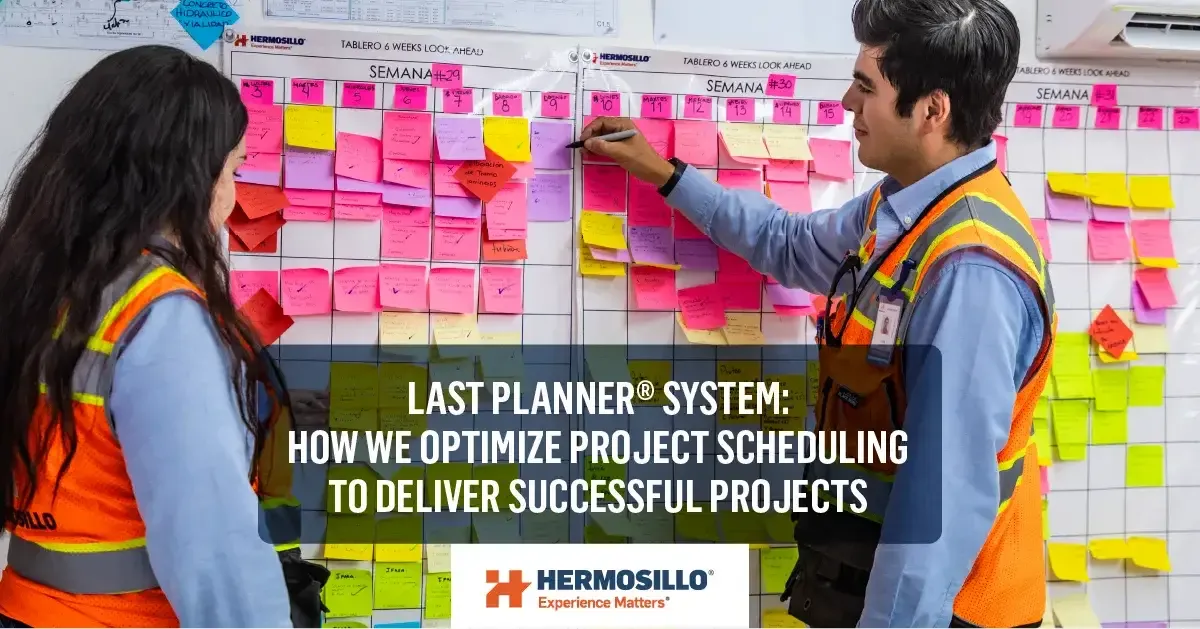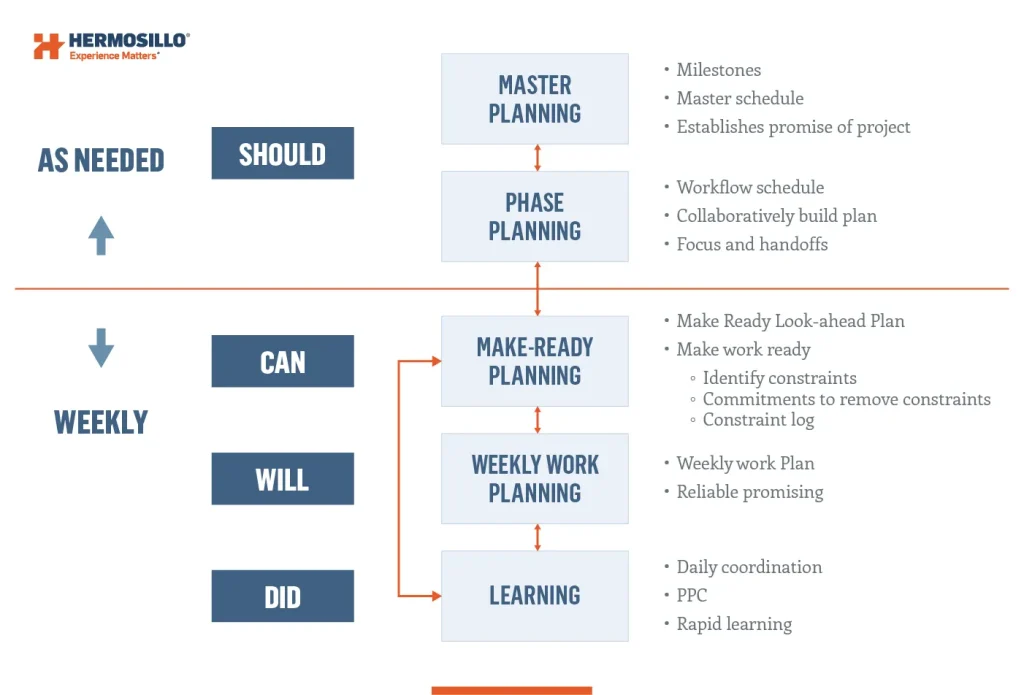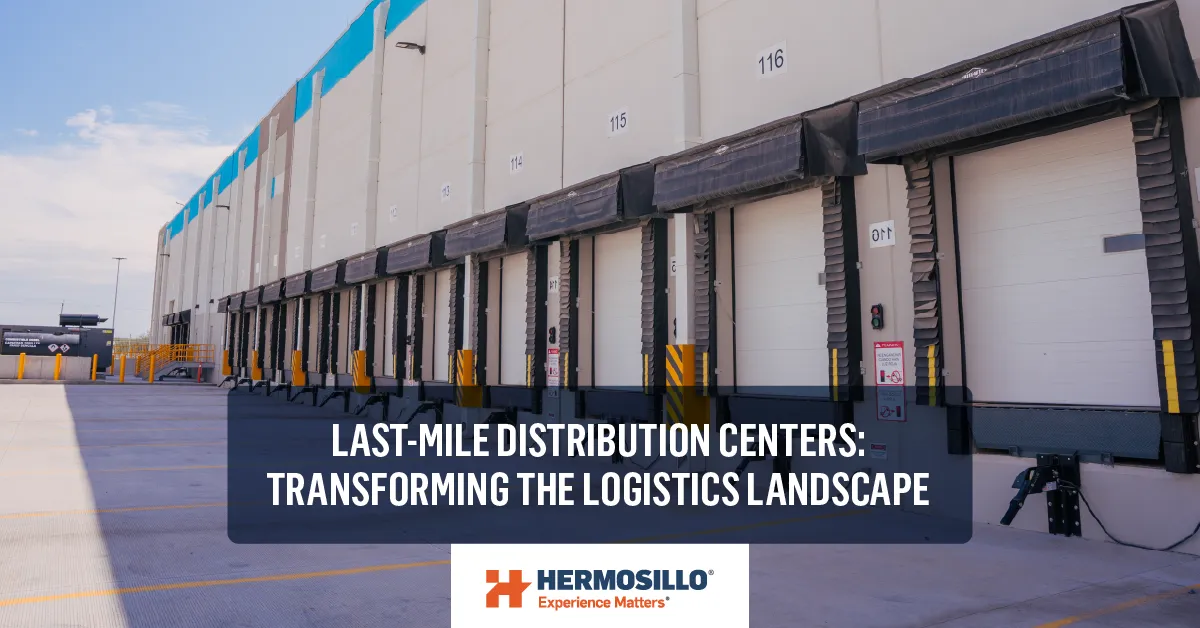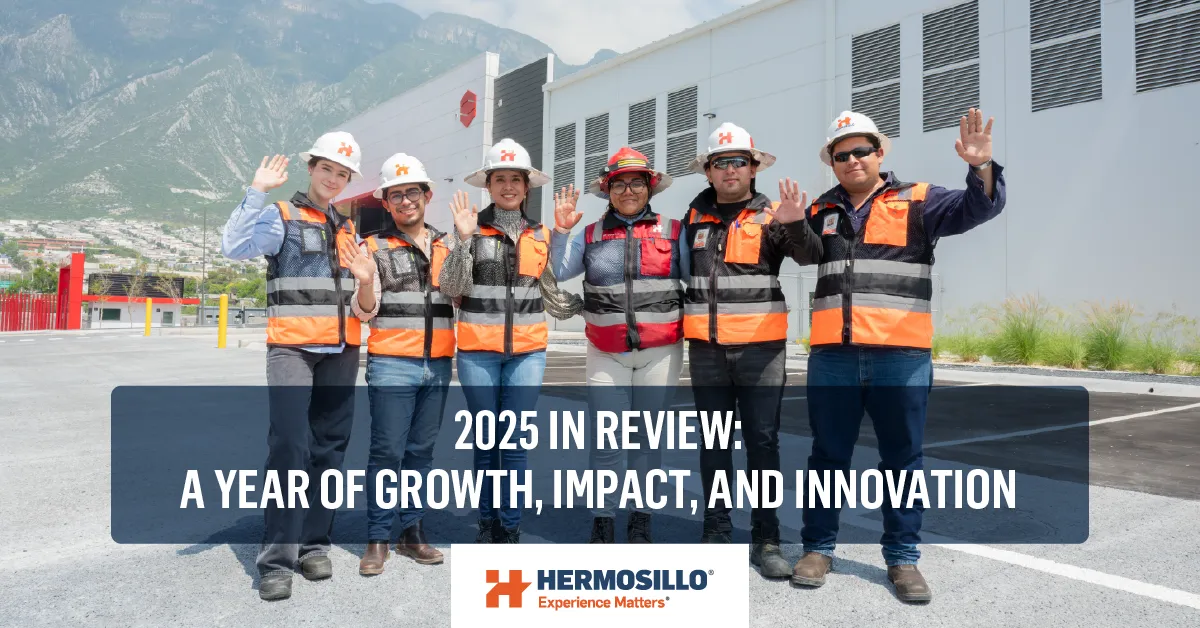
Introduction: The Importance of Project Scheduling in the Construction Phase
In the construction industry, effective planning and efficient execution are key factors for the success of any project. The complexity of coordinating multiple teams, tight deadlines, and limited resources requires a methodology that not only ensures timelines are met and resources are optimized but also allows adaptability to changes while minimizing waste. At Hermosillo, we have adopted the Last Planner System (LPS), which has transformed our culture and project management approach, increasing efficiency and fostering collaboration. Read on to learn more.
What is the Last Planner® System?
According to the Lean Construction Institute, the Last Planner® System (LPS) is a planning methodology designed to create a predictable workflow among all parties involved in a project, ensuring reliable results. Its full name, Last Planner® System of Production Control, reflects its focus on production planning and control, especially in the construction sector.
The LPS helps identify and proactively address potential obstacles before they impact the workflow, allowing for more efficient execution. This system adopts a holistic approach, where all components are essential for effective project planning and execution under lean construction principles. Essentially, each subcontractor involved in the project must commit to managing and completing their scope of work within the agreed timeline. This means detailing the specific activities they will carry out and ensuring all prerequisite tasks are completed before starting a new one.
This structured process increases project predictability, improves productivity and collaboration, and fosters greater responsibility among subcontractors. Additionally, when unexpected issues arise, the Last Planner System facilitates finding alternative routes to meet the set goals, ensuring greater efficiency and control over production.

Benefits of Implementing the Last Planner® System at Hermosillo
At Hermosillo, we have used the Last Planner® System (LPS) in all our projects for over seven years. Our planning culture has improved significantly over this period, and we have seen numerous benefits emerge, transforming how we manage projects and engage with our subcontractors and clients. Below, we outline the LPS’s key advantages, highlighting its impact on communication, collaboration, efficiency, and adaptability.
Strengthening Communication and Collaboration
One of the most notable benefits of the Last Planner System is its improved communication and collaboration across all construction project participants. Before implementing this methodology, planning and follow-up meetings involved only our team members, excluding subcontractor representatives, leading to poor communication and loose coordination between the teams responsible for executing the tasks. This gap resulted in delays and miscommunication.
With the Last Planner System, we emphasize that project scheduling meetings should be attended by those directly responsible for the work. This ensures that information is communicated accurately, enhances decision-making, and increases project productivity. Additionally, all our projects have a Lean coordinator on site, who is crucial in facilitating these meetings and helping teams collaboratively address restrictions and resolve issues before they impact workflow. This approach fosters a transparent environment where all voices are heard, enabling better team coordination and collaboration.
Improved Project Delivery Times and Reliability in Meeting Agreed Deadlines
The Last Planner System has also significantly improved the punctuality of project delivery. We have reduced delays and minimized resource waste through a detailed schedule and constant monitoring. This approach has project milestones with value for our clients.
The methodology also helps us identify potential risks and restrictions early on, allowing us to take preventive actions before they disrupt the project’s progress. By resolving potential issues in advance, we maintain a consistent workflow and ensure the project stays on track without unnecessary interruptions. This continuous monitoring directly improves performance and delivery results.
Fostering Ownership and Accountability
Beyond operational efficiency, the Last Planner System has fostered a strong sense of ownership, collaboration, and accountability among all project participants, including subcontractors. Involving them in planning makes teams feel more invested in the project’s success. This collaborative approach encourages motivation and engagement, creating an environment where every milestone is celebrated as a collective achievement. This sense of ownership enhances productivity and fosters a high level of commitment throughout the project.
Flexibility and Managing Last-Minute Changes
Construction projects are often subject to last-minute changes, and the Last Planner System provides us with the flexibility to manage these adjustments without compromising delivery timelines. One of the key strengths of the LPS is its ability to adapt to real-time project conditions. Subcontractors are involved in planning from the outset, allowing changes to be made collaboratively and efficiently.
Weekly meetings are essential in this process. When changes or delays occur, they are immediately communicated to all involved parties, enabling the team to find solutions quickly. These meetings also help assess whether additional resources, such as personnel or building equipment, are needed to stay on track. Visual tools like the Big Room further enhance communication, ensuring updates are conveyed to subcontractors and keeping the project moving smoothly.
Additionally, we hold daily huddles with our workforce to reinforce coordination and ensure that we analyze restrictions, identify solutions, and keep the entire team engaged in maintaining workflow.
Continuous Adaptation to Project Conditions
The Last Planner System is designed to adapt continuously to the conditions of each project. This flexibility ensures that we can adjust our plans based on realistic expectations, minimizing the risk of last-minute changes negatively affecting the schedule or quality of the work.
Our construction program is treated as a living element and is regularly updated through weekly reviews based on Percent Plan Complete (PPC) results. With Pull Planning, we adjust timelines and activities as needed to ensure that any modifications are handled efficiently, thereby ensuring the project is delivered on time without compromising quality. This is a clear reflection of the lean methodology we embrace as a general contractor.
Conclusion: The Added Value for Our Clients
The Last Planner® System allows us to offer our clients two fundamental values: trust and transparency. Our extensive experience in utilizing this methodology ensures that projects are managed efficiently, meeting deadlines and adhering to agreed-upon quality standards. The active participation of everyone involved, from subcontractors to the client, guarantees that problems are addressed collaboratively and that potential issues are resolved without surprises, minimizing risks and reinforcing trust.
Additionally, the Last Planner System promotes open planning, where project progress is visible to both the team and the client. This enables continuous feedback and ensures that all decisions are made clearly and aligned with the project’s objectives. By offering this transparency, our clients can actively engage in the process, ensuring that every project milestone is met, adding value, and delivering results that meet and exceed expectations.






